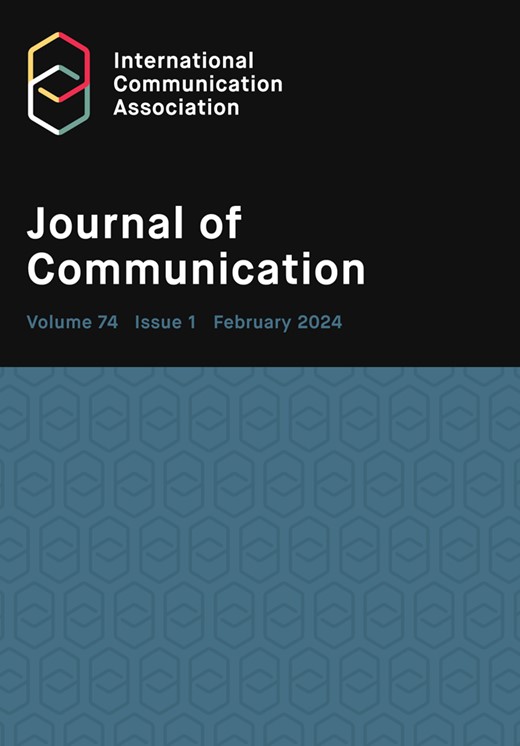Digital Literacy and Media Consumption among Different Age Groups
IF 6.1
1区 文学
Q1 COMMUNICATION
引用次数: 0
Abstract
Purpose: The general objective of the study was to investigate digital literacy and media consumption among different age groups. Methodology: The study adopted a desktop research methodology. Desk research refers to secondary data or that which can be collected without fieldwork. Desk research is basically involved in collecting data from existing resources hence it is often considered a low cost technique as compared to field research, as the main cost is involved in executive’s time, telephone charges and directories. Thus, the study relied on already published studies, reports and statistics. This secondary data was easily accessed through the online journals and library. Findings: The findings reveal that there exists a contextual and methodological gap relating to digital literacy and media consumption among different age groups. The study found significant disparities in digital literacy levels that affected media consumption behaviors. Younger generations, with higher digital literacy, preferred dynamic, interactive digital media, while older adults relied more on traditional media due to lower digital literacy and difficulties navigating digital platforms. Socio-economic status, educational background, and access to technology influenced these disparities. The study emphasized the need for targeted digital literacy initiatives to bridge this divide and promote inclusive media consumption, ensuring all age groups could benefit from digital resources. Unique Contribution to Theory, Practice and Policy: Theory of Diffusion of Innovations, Uses and Gratification Theory and Media Richness Theory may be used to anchor future studies on digital literacy and media consumption among different age groups. The study recommended targeted educational programs to address varying digital literacy levels, suggesting advanced digital skills training for younger generations and user-friendly basic skills training for older adults. It contributed to theory by emphasizing the role of age in digital literacy research and urged the expansion of theoretical frameworks to include socio-economic and educational influences. Practically, it called for age-appropriate digital content and school curricula integration, while policy recommendations included investing in digital infrastructure, supporting public digital literacy programs, and addressing digital privacy and cybersecurity issues to foster an inclusive digital environment.不同年龄组的数字素养和媒体消费情况
目的:本研究的总体目标是调查不同年龄组的数字素养和媒体消费情况。研究方法:本研究采用案头研究方法。案头研究指的是二手数据或无需实地考察即可收集的数据。案头研究基本上是从现有资源中收集数据,因此与实地调查相比,案头研究通常被认为是一种低成本技术,因为主要成本涉及执行人员的时间、电话费和目录。因此,本研究依赖于已出版的研究、报告和统计数据。这些二手数据可通过在线期刊和图书馆轻松获取。研究结果:研究结果表明,不同年龄组在数字素养和媒体消费方面存在着背景和方法上的差距。研究发现,数字素养水平的显著差异影响了媒体消费行为。数字素养较高的年轻一代更喜欢动态、互动的数字媒体,而老年人由于数字素养较低和难以驾驭数字平台,更依赖于传统媒体。社会经济地位、教育背景和获取技术的途径影响了这些差异。研究强调,有必要采取有针对性的数字扫盲措施来弥合这一鸿沟,促进包容性媒体消费,确保所有年龄组都能从数字资源中受益。对理论、实践和政策的独特贡献:创新扩散理论、使用和满足理论以及媒体丰富性理论可用于今后关于不同年龄组数字扫盲和媒体消费的研究。该研究针对不同的数字素养水平提出了有针对性的教育计划,建议为年轻一代提供高级数字技能培训,为老年人提供用户友好型基本技能培训。研究强调了年龄在数字扫盲研究中的作用,并敦促扩大理论框架,将社会经济和教育影响因素纳入其中,从而对理论做出了贡献。在实践中,它呼吁整合适合不同年龄的数字内容和学校课程,而政策建议则包括投资数字基础设施、支持公共数字扫盲计划、解决数字隐私和网络安全问题,以营造一个包容性的数字环境。
本文章由计算机程序翻译,如有差异,请以英文原文为准。
求助全文
约1分钟内获得全文
求助全文
来源期刊

Journal of Communication
COMMUNICATION-
CiteScore
11.60
自引率
5.10%
发文量
41
期刊介绍:
The Journal of Communication, the flagship journal of the International Communication Association, is a vital publication for communication specialists and policymakers alike. Focusing on communication research, practice, policy, and theory, it delivers the latest and most significant findings in communication studies. The journal also includes an extensive book review section and symposia of selected studies on current issues. JoC publishes top-quality scholarship on all aspects of communication, with a particular interest in research that transcends disciplinary and sub-field boundaries.
文献相关原料
| 公司名称 | 产品信息 | 采购帮参考价格 |
|---|
 求助内容:
求助内容: 应助结果提醒方式:
应助结果提醒方式:


